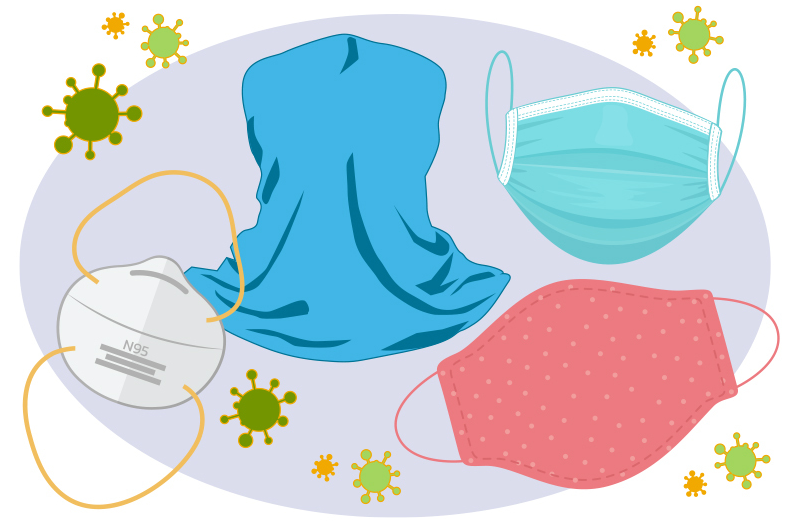The outbreak of the novel coronavirus is a public health emergency that requires global attention. The Centers for Disease Control and Prevention (CDC) and the World Health Organization recommend that everyone wears a face covering regardless of whether they’re infected or not.
This prompted people to run and buy medical-grade masks to protect themselves from getting infected by the disease. This, unfortunately, resulted in a worldwide shortage of medical masks, meaning that even the people in the frontline trying to fight the spread of the virus lacked adequate personal protective equipment (PPE) in the form of face masks.
What people failed to realize is that not all masks are made the same. Different kinds of masks have different kinds of functionalities. With governments saving up on N95 masks for use by healthcare workers, the WHO has recommended that people wear disposable masks or cloth masks as they can do an effective job in protecting the wearer against infection.
In light of this revelation, it’s important that everyone wears a disposable or fabric face mask when they’re out in public.
Let’s take an in-depth look into how the coronavirus spreads and how different kinds of masks can help protect you from contracting the disease.
How Does COVID-19 Spread and What Does It Have To Do With Face Masks
Getting a clear picture of how the coronavirus spreads helps understand why important it is to have the right kind of mask on when out in public.
Scientists and medical experts have been saying for months now that one of the ways COVID-19 is mainly spread happens to be through small respiratory droplets that we emit whenever we cough, talk, or sneeze.
These respiratory droplets, or aerosols, tend to linger in the air for quite some time meaning that if they were emitted by an infected person, anyone who inhales them could get infected by the disease.
Perhaps the strongest evidence that COVID-19 is an airborne disease stems from an aerodynamic study done by Chinese scientists.
The researchers found low levels of airborne viral RNA, the virus’s genetic material, in ventilated patient rooms. They also found high amounts of viral RNA in places where patients and medical workers removed protective gear such as the bathroom areas.
There’s also the fact that some infection cases are asymptomatic. This makes it so easy for the virus to spread from person to person since the carrier won’t know they’re infected and might not feel the need to exercise safety measures.
So which one offers more protection of the two? Read on to find out.
Disposable Face Masks
A disposable mask, or a surgical mask, is primarily designed to help prevent respiratory droplets from being expelled into the immediate environment by the wearer. They are made from multiple layers of non-woven bonded fabric and are not suitable for more than one use.
You’ll find that the design of medical-grade surgical masks prioritizes fluid resistance as compared to its filtration capacity. It offers no respiratory protection to the wearer since it does not seal tightly around the face. This loose structure allows for air to move almost freely around the edges.
There are currently three types of disposable face masks; the type I, type II, and type IIR.
Type I disposable face masks are worn mostly by patients and healthcare workers. They help reduce the spread of infections but offer no resistance to fluids. Type II disposable face masks are made for the use by healthcare workers involved in surgery.
The type IIR disposable masks are made for use by healthcare workers in the operating room but unlike the type II, this particular type of mask offers a bit of respiratory support and is also fluid resistant.
Cloth Face Masks
A cloth face mask is made out of normal fabric material. They are strongly recommended by the WHO because they are easy to make, cheap, and can be easily accessible to the mass public.
A lot of people have actually opted to make cloth masks from their own homes. If you don’t have the skill to do this, you can easily buy one as they are probably the cheapest kind of face mask available. However, there are some things that you need to consider first, the first of which being the material.
The thickness of the fabric used is very important. Try and hold up the cloth mask you want to buy against a light. If you can see the outline of the fibers without too much difficulty, the mask is not going to make a great filter. If possible, look for a cloth mask made out of 100% cotton. Cotton fiber tends to have a 3D structure that does a better job of trapping particles.
Another factor you should look out for in a cloth mask is if it has multiple layers. Masks with several layers are better at trapping tiny particles. Some cloth masks come with a pocket where the wearer can place a filter. If your ideal mask doesn’t have that allowance, try and get one with several layers of tightly woven cotton.
The shape of the mask also matters. How well does it fit around your nose and mouth? You need a cup that will seal tightly around your face such that it allows for easy breathability without leaking air.
So Which Face Mask Is Better?
Just a few months ago, disposable face masks and respirators were worn almost exclusively by professionals such as firefighters and healthcare workers whose line of work required them to do so. However, with the onset of the COVID-19 pandemic, disposable and fabric face masks have become a frequent sight in public settings.
While cloth masks do a good job in trapping biological particles expelled by the wearer, surgical masks are made to protect the wearer from coming into contact with liquids that may splash or splatter across the face.
Disposable face masks are also not as eco-friendly as cloth masks. Cloth masks can be rewashed for reuse while disposable face masks are only made for singular use. Cloth masks are also cheaper and DIYers can easily make them from home.
These reasons make cloth masks the stand-out option and a much better option for society if we’re going to win the war against the coronavirus.
Also Read: A Procedure Isolation Trolley – A Sanitation Boon to The Healthcare World
Image Source: https://discoveries.childrenshospital.org/covid-19-mask-science/
Latest posts by Nirupama Verma (see all)
- What is Corporate Gifting and Why is It Important? - November 8, 2023
- Top 5 Benefits of Synthetic Liquids That You Did Not Know - December 24, 2022
- Pin up Review - September 23, 2022




